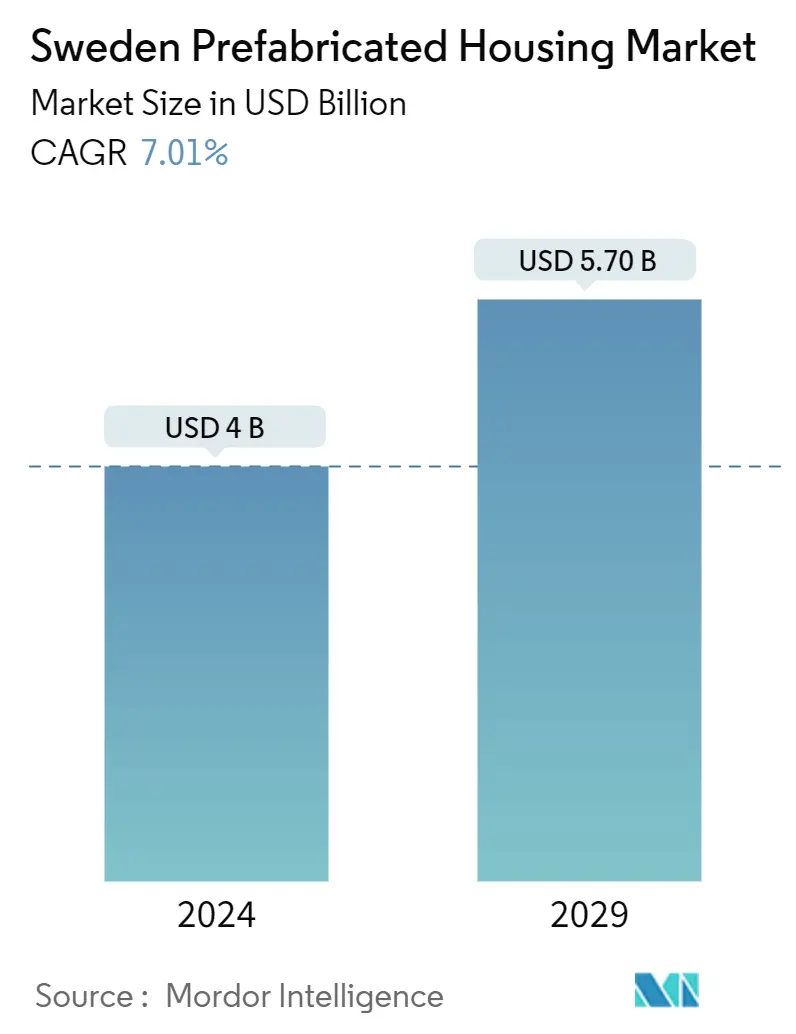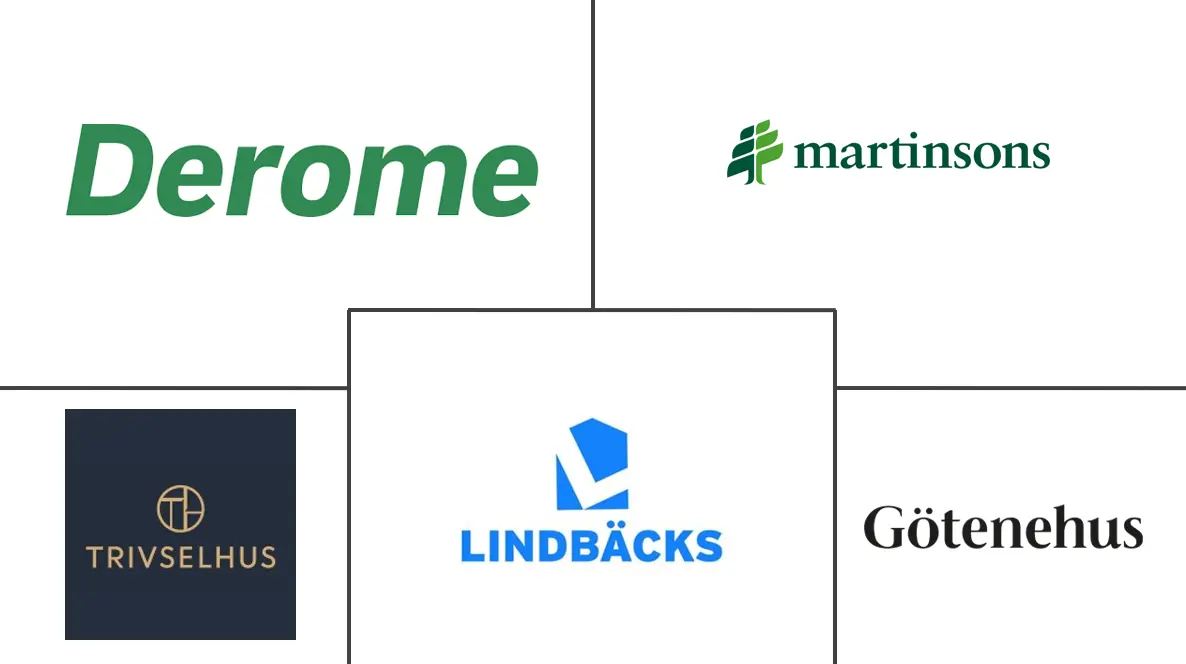Market Size of Sweden Prefabricated Housing Industry

| Study Period | 2020-2029 |
| Base Year For Estimation | 2023 |
| Market Size (2024) | USD 4 Billion |
| Market Size (2029) | USD 5.70 Billion |
| CAGR (2024 - 2029) | 7.01 % |
| Market Concentration | Low |
Major Players
*Disclaimer: Major Players sorted in no particular order |
Sweden Prefabricated Housing Market Analysis
The Sweden Prefabricated Housing Market size is estimated at USD 4 billion in 2024, and is expected to reach USD 5.70 billion by 2029, growing at a CAGR of 7.01% during the forecast period (2024-2029).
- The COVID-19 pandemic in 2020 plunged the global economy into recession and led to declines in prefabricated housing construction in Sweden, as lockdown measures and the need to adjust construction practices to accommodate greater social distancing stopped or slowed projects in the country. Rapid urbanization and the need to overcome housing shortages have provided market space for prefabricated structures.
- The market has some limitations, such as durability issues and a need for appropriate financing options for prefabricated living spaces. Sweden's prefabricated houses are mostly timber-framed, which means they are not radically different from most mid-grade structures design-wise. However, when it comes to production, the process is different from the current industry standard of crews erecting stick-built houses piece by piece. For production, measurements and specifications are planned by computer.
- The demand for low and medium-rise residential buildings, project housing, and public housing drives the market. About 84% of detached houses in Sweden use prefabricated timber elements. Prefabricated metal products are also used to meet modern architectural needs, where the structure of the building has decorative elements with unique shapes. Due to cost-effectiveness and time constraints, the construction sector has an increasing trend to use prefabricated components.
- In 2022, wooden skyscrapers witnessed significant growth in the country. In September 2022, a 20-story, 75-meter-high Sara Cultural Centre opened in the country. This project has six theater stages, a library, two art galleries, a conference center, and a 205-room hotel, and the project is built with 12,000 cubic meters of wood harvested from the nearby forest. This project is eco-friendly and caused significantly fewer carbon emissions during construction. Thus, the prefabricated sector is witnessing significant growth in Sweden.
Sweden Prefabricated Housing Industry Segmentation
Prefabricated homes, often referred to as prefab homes, are primarily manufactured in advance offsite, then delivered and assembled on-site.
This report covers market insights, such as market dynamics, drivers, restraints, opportunities, technological innovation, its impact, Porter's five forces analysis, and the impact of COVID-19 on the market. In addition, the report provides company profiles to understand the competitive landscape of the market.
Sweden's prefabricated housing market is segmented by material and by sector. By material, the market is segmented by concrete, glass, metal, timber, and other materials types. By application, the market is segmented by residential, commercial, and other applications ( industrial, institutional, and infrastructure).
The report offers the market sizes and forecasts for Sweden's prefabricated housing market in value (USD) for all the above segments.
| Material Type | |
| Concrete | |
| Glass | |
| Metal | |
| Timber | |
| Other Material Types |
| Application | |
| Residential | |
| Commercial | |
| Other Applications ( Industrial, Institutional, and Infrastructure) |
Sweden Prefabricated Housing Market Size Summary
The Sweden prefabricated housing market is poised for significant growth, driven by rapid urbanization and the need to address housing shortages. The market is characterized by a strong demand for low and medium-rise residential buildings, project housing, and public housing. Prefabricated timber elements dominate the sector, with a substantial portion of detached houses utilizing these components. The construction industry is increasingly adopting prefabricated solutions due to their cost-effectiveness and efficiency, particularly in the face of skills shortages in traditional construction trades. Sweden's leadership in offsite manufacturing is underscored by its high percentage of factory-built wooden houses, which are primarily constructed using closed wall panels. The country's unique climatic conditions and abundant premium-quality timber have further bolstered its position in the prefabricated housing sector.
Despite the challenges posed by the COVID-19 pandemic, which initially slowed construction activities, the Swedish prefabricated housing market has shown resilience. The government's less stringent lockdown measures allowed the construction industry to perform better than many of its European counterparts. The market remains competitive and fragmented, with major players like Derome AB, Martinson Group AB, Lindbacks, and Trivselhus AB leading the charge. The adoption of technology and energy-efficient solutions, such as solar-powered houses, is gaining traction, aligning with the growing demand for sustainable housing options. The market's growth is further supported by the import of prefabricated buildings from countries like Estonia, Latvia, and China, meeting the increasing demand for modular housing units.
Sweden Prefabricated Housing Market Size - Table of Contents
-
1. MARKET INSIGHTS
-
1.1 Current Market Scenario
-
1.2 Technological Trends
-
1.3 Insights on Supply Chain/Value Chain Analysis of the Prefabricated Buildings Industry
-
1.4 Brief on Different Structures Used in the Prefabricated Buildings Industry
-
1.5 Cost Structure Analysis of the Prefabricated Buildings Industry
-
1.6 Impact of COVID 19
-
-
2. MARKET SEGMENTATION
-
2.1 Material Type
-
2.1.1 Concrete
-
2.1.2 Glass
-
2.1.3 Metal
-
2.1.4 Timber
-
2.1.5 Other Material Types
-
-
2.2 Application
-
2.2.1 Residential
-
2.2.2 Commercial
-
2.2.3 Other Applications ( Industrial, Institutional, and Infrastructure)
-
-
Sweden Prefabricated Housing Market Size FAQs
How big is the Sweden Prefabricated Housing Market?
The Sweden Prefabricated Housing Market size is expected to reach USD 4 billion in 2024 and grow at a CAGR of 7.01% to reach USD 5.70 billion by 2029.
What is the current Sweden Prefabricated Housing Market size?
In 2024, the Sweden Prefabricated Housing Market size is expected to reach USD 4 billion.

